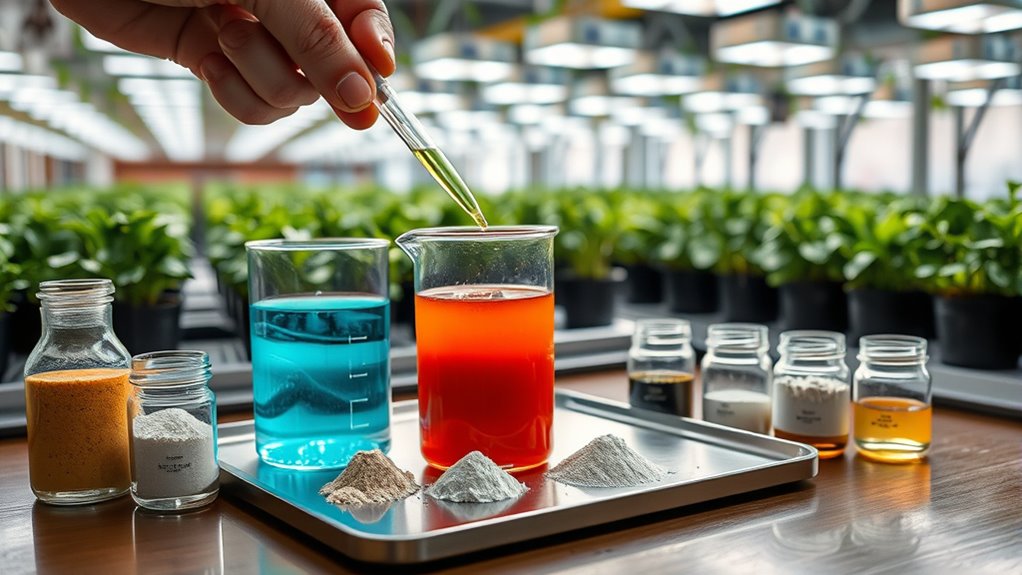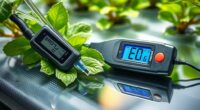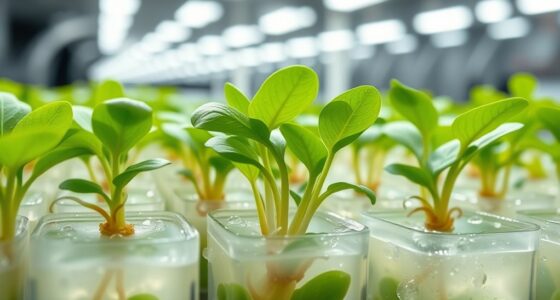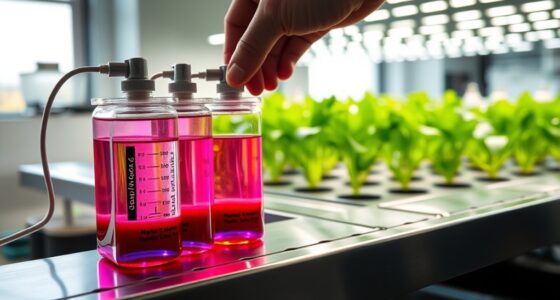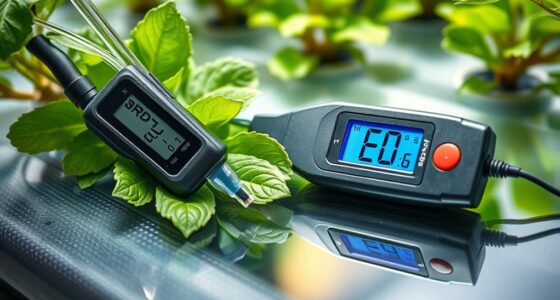To craft your own hydroponic plant food, start by understanding the essential nutrients plants need, like nitrogen, phosphorus, potassium, and trace minerals. Use ingredients like composted manure, eggshells, seaweed extract, and blood meal to create a balanced mix. Properly prepare, mix, and store your solution in sanitized containers, and regularly monitor pH and nutrient levels. If you want to learn detailed steps on mixing, adjusting, and troubleshooting your homemade fertilizers, keep exploring further.
Key Takeaways
- Use natural ingredients like composted manure, eggshells, seaweed extract, and blood meal to customize nutrient solutions.
- Measure and mix ingredients thoroughly with filtered or distilled water, monitoring pH to ensure optimal nutrient availability.
- Adjust pH levels with acids or bases using calibrated meters to maintain a range of 5.5-6.5 for healthy plant uptake.
- Store DIY fertilizers in clean, labeled, airtight containers in cool, dark places, and check concentrations regularly.
- Regularly test EC and pH, troubleshoot deficiencies, and follow safety protocols to ensure healthy, safe hydroponic growth.
Understanding the Essential Nutrients for Hydroponic Plants
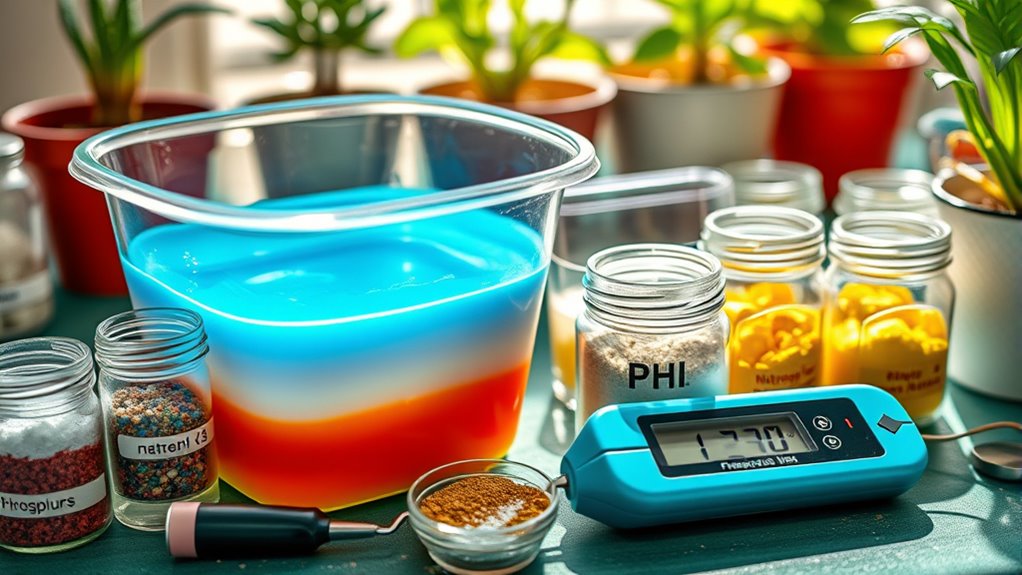
To grow healthy hydroponic plants, you need to understand the essential nutrients they require. Your plants’ genetics influence their specific nutrient needs, so knowing their genetic makeup helps you tailor your solutions. While soil amendments are crucial in traditional gardening, in hydroponics, you supply nutrients directly through your solution. Key nutrients include macronutrients like nitrogen, phosphorus, and potassium, which support growth, flowering, and fruiting. Micronutrients such as iron, manganese, and zinc are also vital for enzyme functions and overall health. Since hydroponic plants rely solely on your nutrient solution, understanding how plant genetics affect nutrient uptake allows you to customize your mix for optimal growth. This knowledge helps you create a balanced, effective DIY fertilizer tailored to your plants’ unique needs. Additionally, understanding plant nutrient requirements can help prevent deficiencies or toxicities, ensuring healthier and more productive plants.
Common Ingredients for DIY Hydroponic Fertilizers

Creating effective DIY hydroponic fertilizers requires familiarizing yourself with common ingredients that supply essential nutrients. These ingredients often include soil amendments and organic additives, which help provide balanced nutrition. Notable examples include:
Familiarize yourself with key ingredients like composted manure, eggshells, seaweed extract, and blood meal for effective DIY hydroponic fertilizers.
- Composted manure – rich in nitrogen and organic matter.
- Crushed eggshells – a source of calcium for strong cell walls.
- Seaweed extract – supplies potassium and trace minerals.
- Blood meal – offers readily available nitrogen for healthy leaf growth.
Additionally, understanding the impact of clean fuel injectors on vehicle performance can inform the selection of nutrient sources for hydroponics, ensuring optimal plant health and growth.
These ingredients are versatile and can be combined to tailor your nutrient solutions. Using soil amendments and organic additives ensures your plants receive natural, nutrient-dense feeds. Remember, understanding each ingredient’s role helps optimize your DIY hydroponic fertilizer’s effectiveness.
Preparing Your Base Solution
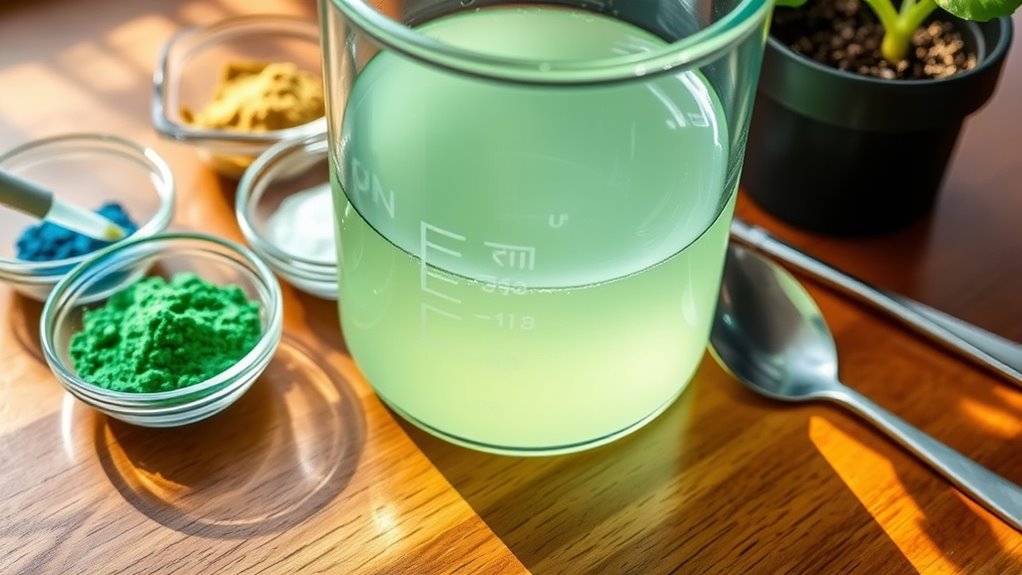
Before mixing your nutrients, it’s vital to prepare a clean, balanced base solution. Start by testing your soil to understand existing nutrient levels and plant health needs. This helps you avoid over- or under-supplying nutrients. Use filtered or distilled water to prevent contaminants that could affect your plants. Confirm your containers are sanitized to maintain a sterile environment. Here’s a quick overview:
| Step | Purpose |
|---|---|
| Soil testing | Assess existing nutrients |
| Use clean water | Prevent contamination |
| Sanitize containers | Maintain plant health |
| Measure pH of water | Confirm proper nutrient uptake |
| Mix thoroughly | Create a uniform base |
Additionally, understanding the history of pinball machines can inspire innovative design elements in your hydroponic setup, blending entertainment and functionality. This preparation sets the foundation for a healthy, productive hydroponic system.
Incorporating Macronutrients: Nitrogen, Phosphorus, and Potassium
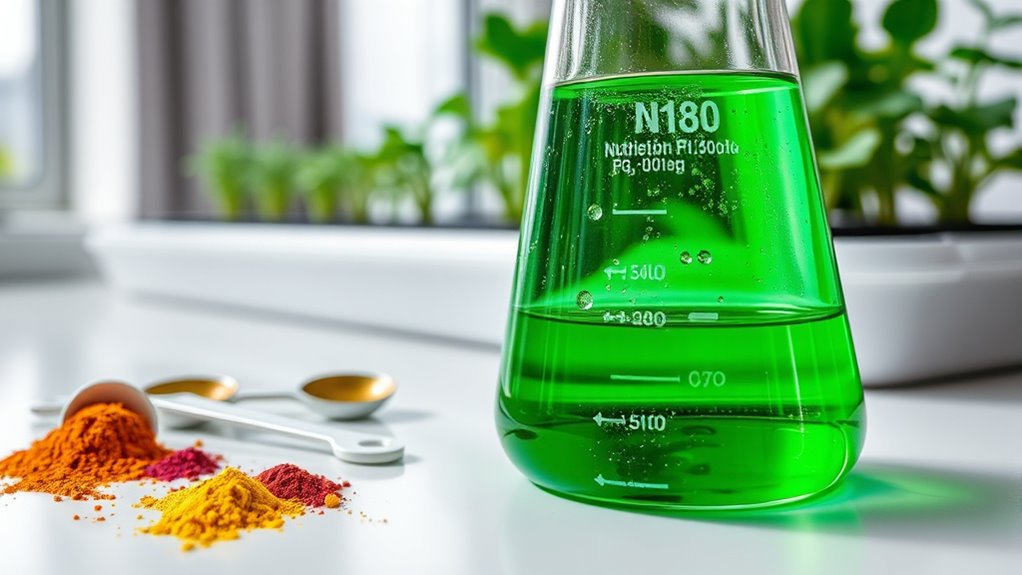
You need to understand the roles of nitrogen, phosphorus, and potassium to create an effective nutrient mix. Balancing these macronutrients guarantees your plants grow strong and healthy. Adjusting their ratios helps you meet your plants’ specific needs at different growth stages. Incorporating expert voice actors into your approach can help you communicate your gardening tips more effectively to a broader audience.
Essential Nutrient Roles
Have you ever wondered why certain nutrients are crucial for plant growth? Macronutrients like nitrogen, phosphorus, and potassium play essential roles in supporting healthy development. Without them, plants can suffer from nutrient deficiency, stunting growth or causing other problems. Here’s what each does:
- Nitrogen: Promotes lush, green foliage and overall vegetative growth.
- Phosphorus: Supports energy transfer and root development.
- Potassium: Regulates water uptake and strengthens plant resilience.
- Synergy: These nutrients work together to ensure healthy, vigorous plants. If any are lacking, growth slows, and deficiencies appear. Understanding these roles helps you craft nutrient solutions that prevent deficiencies and foster robust plant growth. Properly balanced macronutrients are the foundation of thriving hydroponic systems, especially considering the importance of local knowledge to optimize plant health.
Balancing Macronutrient Ratios
Achieving the right balance of macronutrients—nitrogen, phosphorus, and potassium—is essential for ideal plant growth. Proper ratios support strong roots, vibrant leaves, and healthy flowering. When balancing these nutrients, consider how they interact with your soil remediation efforts and pest management. Too much nitrogen can lead to lush foliage but weak stems, while excess phosphorus may hinder nutrient uptake. Potassium helps regulate water and strengthens plant defenses. Visualize this balance with the following:
| Nutrient | Function | Ideal Role in Growth |
|---|---|---|
| Nitrogen | Promotes leaf and stem growth | Foundation for photosynthesis |
| Phosphorus | Encourages root and flower development | Early growth and flowering |
| Potassium | Improves water uptake and pest resistance | Overall plant health |
| Deficiency | Stunted growth, yellowing | Soil imbalance, pest vulnerability |
| Excess | Nutrient runoff, pests | Poor soil remediation |
Additionally, maintaining proper nutrient levels is crucial for skincare product effectiveness, as nutrient imbalances can negatively impact plant health and yields.
Adding Micronutrients for Optimal Growth
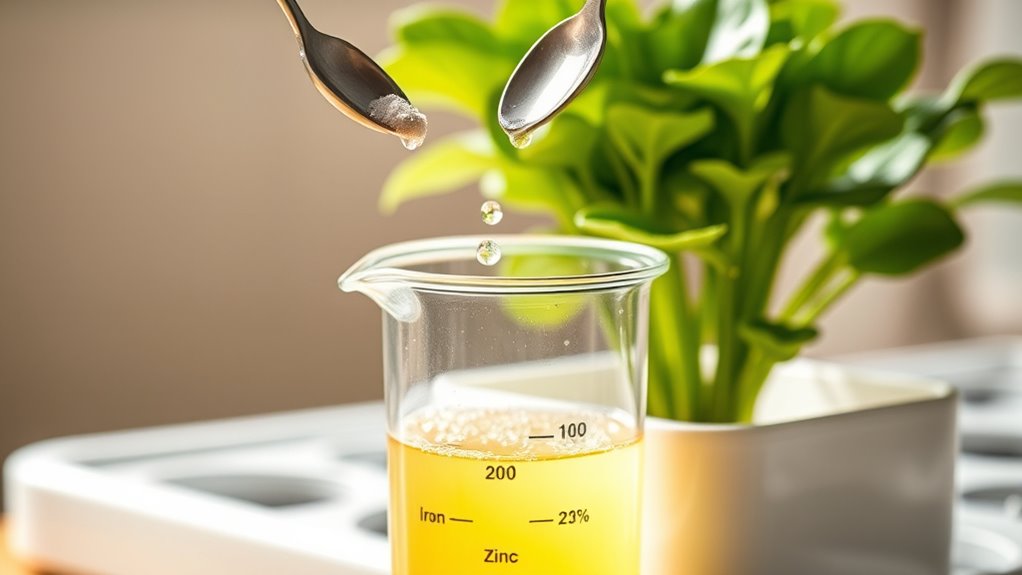
Adding micronutrients is vital for ensuring plants reach their full growth potential, as these trace elements support essential physiological processes. Proper trace mineral supplementation prevents micronutrient deficiency symptoms like leaf discoloration or stunted growth. To incorporate micronutrients effectively, consider these steps: 1. Identify missing minerals through deficiency symptoms. 2. Use a balanced mix of iron, manganese, zinc, and copper. 3. Adjust concentrations based on plant stage and health. 4. Regularly monitor plant response and adjust accordingly. Ensuring a balanced nutrient profile helps maintain overall plant vitality and optimal development.
Balancing Ph Levels in Your Homemade Solution
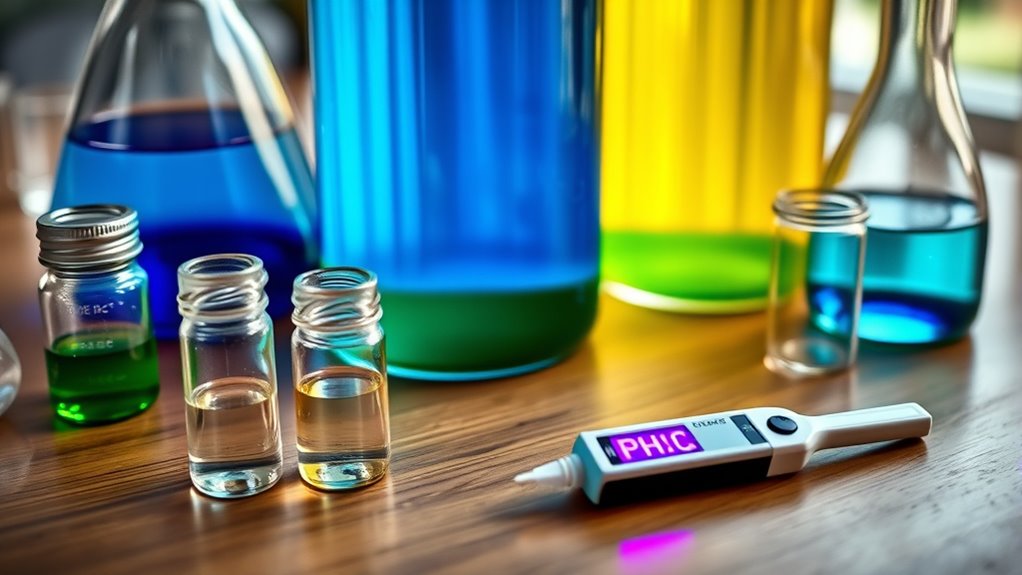
You need to keep your nutrient solution’s pH in the right range for healthy plant growth. To do this, you’ll use pH adjustment techniques like adding acids or bases and regularly monitor the levels with a reliable tester. Staying on top of these steps guarantees your plants absorb nutrients effectively. Additionally, maintaining proper water quality ensures your hydroponic system remains optimal and free from contaminants.
Ph Adjustment Techniques
Balancing pH levels in your homemade nutrient solutions is essential for ideal plant health and nutrient uptake. To do this effectively, start with pH meter calibration to ensure accurate readings. When adjusting pH, follow these techniques:
- Use a calibrated pH meter for precise measurement.
- Perform acid/base titration to gradually modify pH—add small amounts of pH up or down solution.
- Keep stirring the solution continuously for even distribution.
- Test frequently and record pH after each adjustment to avoid overshooting target levels.
- Proper hydroponic nutrient solutions are vital for optimal plant growth and can be fine-tuned through pH adjustments.
Monitoring Ph Levels
After adjusting the pH levels, consistent monitoring guarantees your nutrient solution stays within the ideal range. Regular pH testing helps you catch fluctuations early, ensuring your plants absorb nutrients efficiently. Use a reliable pH meter or test strips to check levels daily. If the pH drifts out of the optimal range (around 5.5-6.5), perform acid adjustment by adding small amounts of pH down solutions like phosphoric acid or citric acid. Keep a record of your readings to identify patterns and maintain stability. Proper monitoring prevents nutrient lockout and promotes healthy growth. Detecting passive voice in your writing can also improve clarity and readability.
Tips for Mixing and Storage of Nutrient Solutions
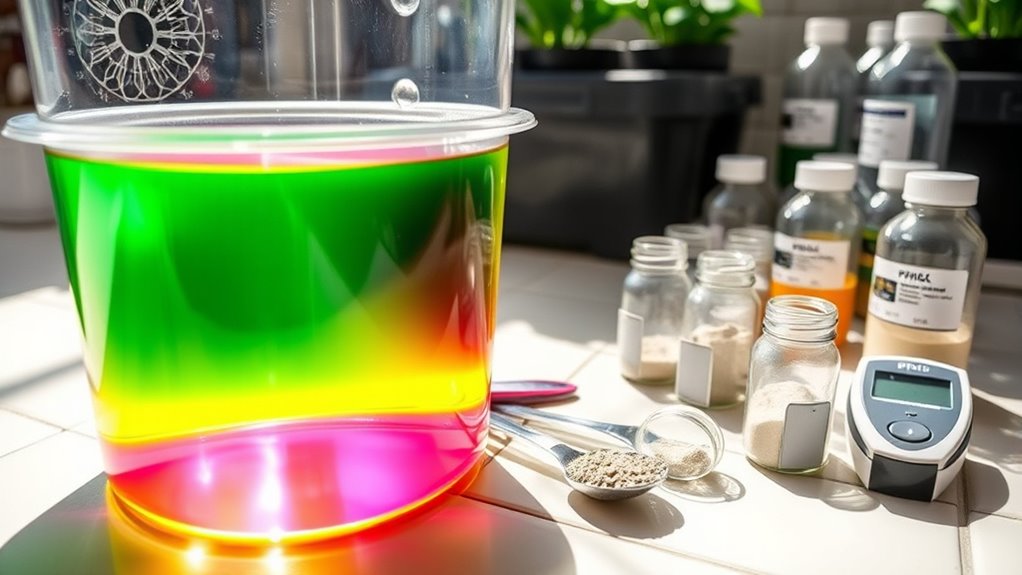
Proper mixing and storage are essential to maintaining the effectiveness of your nutrient solutions. To guarantee quality, follow these tips:
- Use clean, airtight storage containers to prevent contamination and spoilage.
- When mixing, add nutrients gradually, stirring continuously with proper mixing techniques to ensure even distribution.
- Store solutions in a cool, dark place to avoid degradation from light and heat.
- Label containers clearly with contents and date to track freshness and avoid mix-ups.
- Regularly check the concentration and pH levels of your solutions to ensure optimal nutrient delivery.
Monitoring and Adjusting Nutrient Concentrations
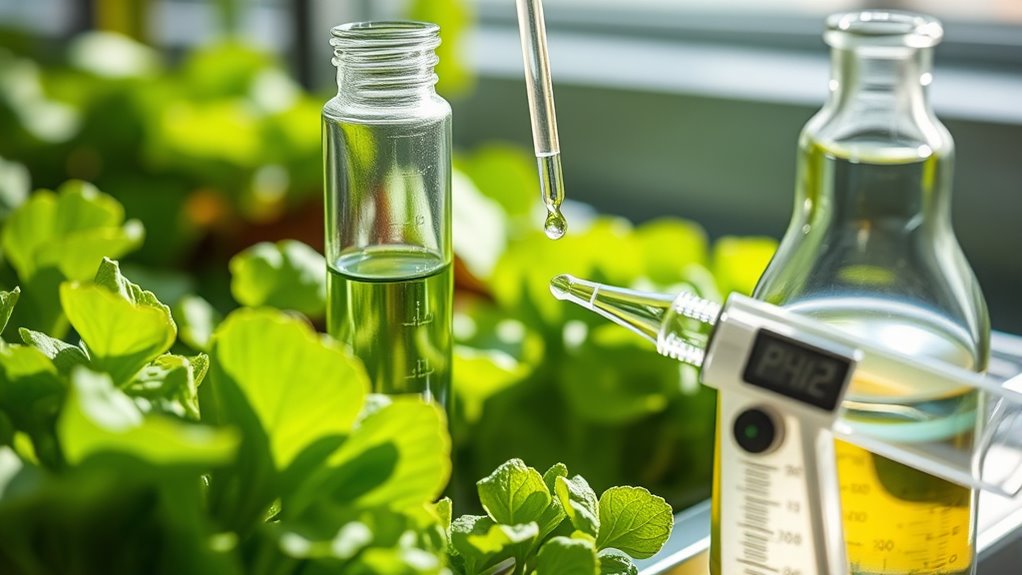
Monitoring and adjusting your nutrient concentrations is crucial to guarantee your plants receive the right amount of nutrients for healthy growth. Regularly test your solution’s electrical conductivity (EC) and pH levels to ensure ideal absorption. Proper monitoring helps prevent deficiencies and excesses that could weaken your plants or attract pests. Remember, lighting optimization influences nutrient uptake, so adjust your environment accordingly. Keep a close eye on your plants’ responses and tweak nutrient levels as needed. Additionally, understanding Kia Tuning options can help you customize your nutrient delivery for optimal plant health. Here’s a quick emotional guide:
| Feelings When Properly Monitored | Consequences of Neglect |
|---|---|
| Confident in healthy growth | Stress and disease vulnerability |
| Excited to see thriving plants | Pest problems and nutrient deficiencies |
| Satisfied with your setup | Waste of resources and time |
Troubleshooting Common Issues With Homemade Fertilizers

Troubleshooting common issues with homemade fertilizers requires you to identify and address problems promptly to maintain healthy plant growth. First, check for nutrient deficiencies, which often manifest as discoloration or stunted growth. Second, ensure pest control measures are effective, as pests can interfere with nutrient uptake. Third, verify your lighting enhancement; inadequate or uneven lighting can cause plants to weaken despite proper fertilization. Fourth, examine your fertilizer mix for imbalances or contamination—incorrect ratios or impurities can harm plants. Regularly monitor plant responses and adjust your nutrient solution accordingly. Addressing these issues quickly helps prevent long-term damage, keeps pest populations in check, and guarantees your plants receive the proper nutrients for optimal growth.
Safety Precautions and Best Practices
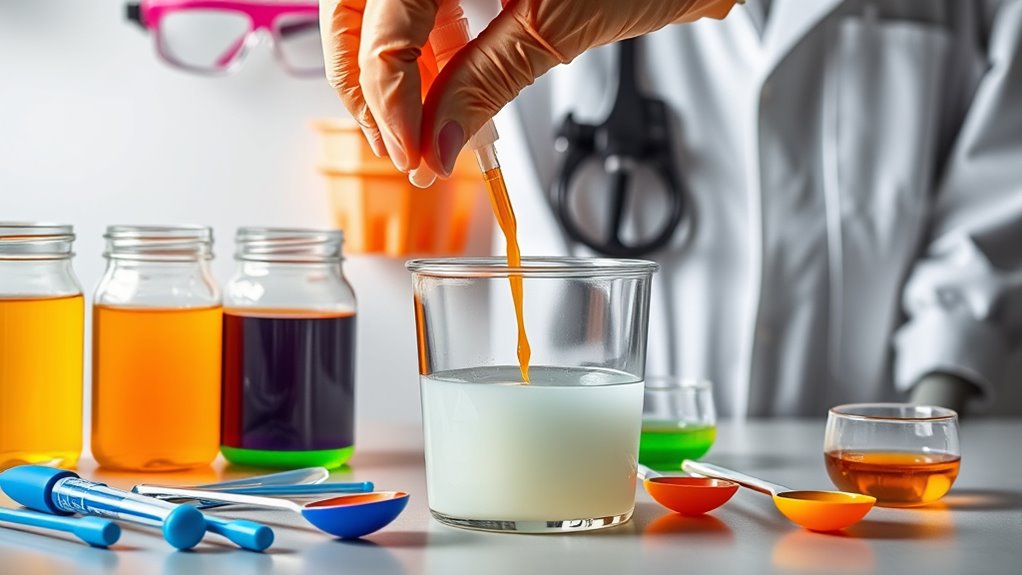
To keep yourself safe while making nutrient solutions, you need to handle chemicals carefully and follow proper techniques. Accurate measurement is essential to avoid harmful imbalances, so use reliable tools and double-check your work. Also, store your ingredients properly and dispose of any leftovers responsibly to prevent accidents and environmental harm. Being aware of exfoliation benefits can help you understand how ingredients like glycolic acid promote healthier skin while ensuring safe handling practices.
Proper Handling Techniques
Handling nutrient solutions safely is essential to prevent health hazards and environmental damage. Always wear personal protective equipment, such as gloves, goggles, and masks, to avoid skin and eye contact. Store solutions in properly labeled, sealed containers to prevent leaks and contamination. When preparing or transferring solutions, follow these best practices:
- Use designated tools and avoid cross-contamination.
- Keep solutions away from children and pets.
- Work in well-ventilated areas to avoid inhaling fumes.
- Clean spills immediately with appropriate absorbent materials.
- Be aware that improper handling can significantly increase the risk of accidents or exposure security considerations.
Proper storage guarantees solutions remain stable and safe, reducing risks. Always follow manufacturer guidelines for storage temperatures and disposal. By adhering to these handling techniques, you safeguard your health and protect your environment.
Accurate Measurement Methods
Accurate measurement of nutrient solutions is essential for ensuring plant health and maintaining safety. To achieve this, use digital scales for precise weighing of dry ingredients, especially when dealing with small quantities. Measuring cups are helpful for liquids and larger amounts, but always double-check measurements to avoid errors. Keep your tools clean and calibrated regularly to guarantee accuracy. Always add ingredients gradually, especially when mixing concentrated solutions, to prevent spills or over-concentrations. Wear protective gear like gloves and goggles to avoid contact with concentrated nutrients. Label your measurements clearly and record them for future reference. Remember, even small inaccuracies can harm your plants or pose safety risks, so take your time and verify your measurements at each step. Incorporating automation’s role in data analysis can further enhance the precision of your measurements and adjustments in hydroponic systems.
Storage and Disposal
Proper storage and disposal of nutrient solutions help prevent accidents and environmental harm. To do this effectively:
- Sterilize containers regularly to prevent bacterial growth and maintain nutrient integrity.
- Store solutions in clearly labeled, airtight containers to extend nutrient shelf life and avoid contamination.
- Keep unused solutions away from children and pets, in a secure, shaded location.
- Dispose of expired or unused nutrients according to local regulations, avoiding runoff into water sources.
- Use appropriate headphone connection methods to ensure safe and effective device compatibility and prevent damage.
Frequently Asked Questions
How Often Should I Change or Refresh My Homemade Nutrient Solution?
You should refresh your homemade nutrient solution every 1 to 2 weeks to maintain proper solution concentration and prevent nutrient imbalances. Regularly check the pH and electrical conductivity (EC) to guarantee ideal levels. Don’t forget to clean your container thoroughly before refilling to avoid algae or bacterial growth. Freshening your solution regularly keeps your plants healthy and maximizes growth, making your hydroponic system more efficient and productive.
Can I Use Household Waste or Kitchen Scraps in My DIY Fertilizer?
Thinking of turning household waste into plant food? Sure, if you enjoy kitchen scrap composting adventures! While recycling household waste sounds eco-friendly, using kitchen scraps in your DIY fertilizer can be tricky. Some scraps may invite pests or fungi, turning your garden into a biohazard zone. Stick to composting methods designed for plant nutrients, and avoid risky kitchen waste mishaps—your plants (and nose) will thank you.
What Signs Indicate Nutrient Deficiencies in Hydroponic Plants?
You’ll notice nutrient deficiencies in your hydroponic plants through symptoms like yellowing leaves and stunted growth. Yellowing leaves often indicate a lack of nitrogen, while slow or halted growth can signal deficiencies in other essential nutrients like potassium or phosphorus. Regularly monitor your plants, and if you see these signs, consider adjusting your nutrient solution to restore proper balance and promote healthy development.
Are There Eco-Friendly or Biodegradable Ingredients for DIY Solutions?
You can definitely find eco-friendly ingredients for your DIY hydroponic solutions. Look for compostable ingredients like seaweed extract, fish emulsion, or plant-based nutrients such as alfalfa meal and kelp powder. These biodegradable options nourish your plants while reducing environmental impact. Using plant-based nutrients and compostable ingredients supports sustainable gardening and helps keep your hydroponic system eco-friendly.
How Do I Prevent Algae Growth in My Nutrient Storage Containers?
Algae growth is like unwanted weeds in your garden—quick to sprout if left unchecked. To prevent algae, guarantee proper container sterilization before filling, using a mild bleach solution or boiling water. Keep your nutrient storage containers sealed tightly to limit light exposure, which algae love. Regularly clean and rinse your containers, and consider adding a small amount of hydrogen peroxide to inhibit algae prevention, keeping your hydroponic system clear and healthy.
Conclusion
Creating your own hydroponic nutrient solution is rewarding and cost-effective. Did you know that plants need over 60 essential nutrients to thrive? By understanding and carefully mixing these nutrients, you can optimize your plant’s growth and health. Just remember to monitor your solutions regularly and follow safety tips. With a little effort, you’ll enjoy lush, healthy plants, proving that DIY hydroponic fertilizers can be both simple and highly effective.
